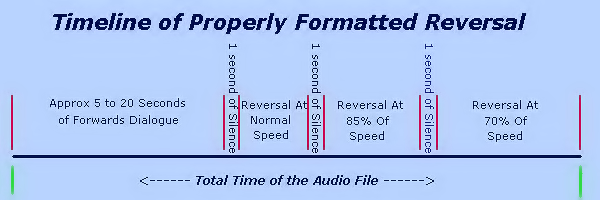As Developed By David John Oates
Prelude
Properly formatting an example of Reverse Speech is important to the analysis of the Reversal and is not just an arbitrary selection of audio cuts put together in a random order. During the analyzation process, the important relationship between the forwards and the reverse must be preserved in order to accurately derive any meaning from the single example of Reverse Speech or a Reversal. This relationship, the fact that the Reversal refers to or relates to the topic that is being discussed forwards, is what dictates the format so that one may understand what the Reversal means. This proper format also precipitates the ease of checking the example by anyone else using the detailed techniques for analyzation and promotes a standardization throughout the industry and analyzation process.
Anatomy of an Example
Before you can begin, you must understand that your objective is to create an example of a single Reversal or sentence that occurs in reverse and then save it to it’s own audio file so that you may play just that example, without having to play the whole forwards audio file. The Reversal must be cut cleanly and accurately out of the main audio file then saved to it’s own audio file. By cleanly and accurately we mean there can be no extra sounds before the first letter of the beginning of the Reversal and no extra sounds after the last letter in the Reversal. This can be accomplished in most audio editors but in the Reverse Speech Professional software, this process is automated.
Now, understanding that, you can then move on to how to construct the Reversal example. Here are the requirements of what the Reversal example must contain. First, the Reversal example must contain enough of the forwards dialogue that you or any listener can determine the topic that is being discussed forwards. This is usually about 5 to 20 seconds of the forwards dialogue, centered either side right where the Reversal occurs, and is important because the Reversal itself will be referring to the topic in the forwards dialogue.
Next, you need the cleanly cut Reversal as it occurs in reverse and you must present the Reversal at 3 speeds. Normal speed, 85% of speed and 70% of speed. This is so you can determine the validity of the Reversal, syllable count, vowel count, and consonant count accurately, and check the Reversal against the 7 checkpoints and other factors necessary to the analyzation process. This also makes it easy for anyone else to check these factors for themselves and verify the validity of the Reversal.
Lastly, you must take these 4 audio cuts, the forwards and the Reversal at 3 speeds, then paste them all into the same file with 1 second of silence between each one. Once you have all 4 audio cuts pasted into the same file you then save this file as one single file and this is what we call a properly formatted Reversal example. Below is an illustration of a time line of a properly formatted Reversal.

Waveform Of A Properly Formatted Reversal
Below is an image of what a properly formatted Reversal looks like in it’s waveform. This audio file or Reversal has been opened in the Reverse Speech Professional audio editor for viewing and playing. One of the best features of the Reverse Speech Pro software is it’s ability to save examples into the proper format automatically. We use to have to build these Reversal examples one audio cut at a time which was a very time consuming endeavor but now with Reverse Speech Pro, we simply highlight and bookmark the forwards and the Reversal, then select them from a list and press a button and the example is saved to it’s proper format. All you have to do is give the file a name. This has greatly reduced the work load for both students and professionals alike and has really made Reverse Speech much easier and quicker to access for important information and guidance.

Should you need further assistance with understanding the proper formatting feel free to contact us with your questions. We are also available for assistance with setting up and using the Reverse Speech Professional software for analyzing speech in reverse.